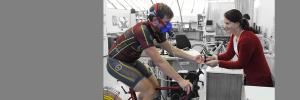
Sport Science now housed at FMHS
Stellenbosch University's Sport Science Department – the first department of its kind in Africa – has, this year, moved from resorting under the Faculty of Education to falling under the Faculty of Medicine and Health Sciences (FMHS).
The department – which has been going for 82 years – will still be physically based in Stellenbosch, at the Coetzenburg Sports Stadium as opposed to moving closer to the FMHS which is mainly located in Tygerberg.
Dr Heinrich Grobbelaar, senior lecturer and executive head of the department, explained the rationale for the move. “The Sport Science Department started in 1936 as a Physical Education Programme under the Faculty of Education and we have been part of the Faculty ever since. We received departmental status in 1940. However, after Physical Education fell by the wayside and was replaced by Life Orientation in the school curriculum, we had to diversify our academic offering. This has led to the reality that we no longer teach that many modules in the programmes of the Faculty of Education. Instead we focus on the training of biokineticists, kinderkineticists and high-performance sports sciences," Grobbelaar said.
“We offer a BSc or BA undergraduate programme, from which students can go on to do honours in one of those three courses. Many students come into those programmes with a science background, while others come from more of a social science background," Grobbelaar continued.
He said one of the main drivers of the move from Education to Medicine was because the biokinetics programme is affiliated with the Health Professions Council of South Africa (HPCSA).
“In a few of the departmental reviews and HPCSA accreditation visits, the recommendation to the university, was to consider moving us to the FMHS in order to align our current academic offering with what they offer on that side.
“The other driver is that we have a close collaboration with the Institute of Sport and Exercise Medicine (ISEM), even though we are separate entities. ISEM is housed at Tygerberg, and, as part of our move to the FMHS, it is envisaged that the institute will build a living laboratory adjacent to our existing building on the Coetzenburg campus. While it is important to distinguish that we are an academic department and they are an institute, we will work together – but we are not one and the same thing," he said.
Grobbelaar believes the move is a good one. “Firstly, it means we will be in an environment where we can truly align what we currently offer with what is already being offered at the FMHS. The biokinetic students, in particular, will be able to network more closely with affiliated health professionals like doctors, physiotherapists etc. That is our biggest immediate opportunity. Secondly, there are more opportunities to apply for improved and updated laboratory equipment at the FMHS.
“Another big opportunity will be the fact that we can expand our collaborations with experts at the FMHS. We have always believed there is a lot of room for collaboration between Sports Sciences and experts in the broad medical field."
Grobelaar said he is excited about the move. “There will be a few challenges in getting all the processes aligned but these are just teething problems which will be sorted out in the next couple of months. The students we have spoken to have responded really well to the announcement too."
